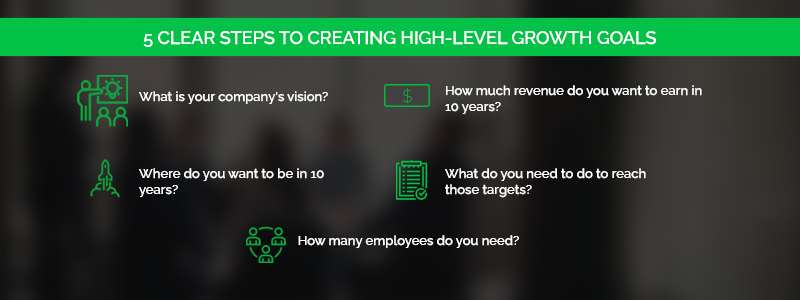5 Clear Steps to Creating High-Level Growth Goals

The way you set your goals can make or break your success. Check out strategies for shaping high-level growth goals.

When you're busy, it’s hard to look ahead. You may get so bogged down in the week-to-week (or minute-to-minute) grind that you think you don't have time for anything else. This can breed stress and discontent in your personal life, but it can be disastrous for your business as well.
If you want your business to grow, set goals. Think about the future. While it's critical to think about tomorrow, next week, and next month, you need to look further into the future. Where do you want to be? What are your long-term plans? When you define your goals for your business, it's easier to plan.
By setting high-level goals, you avoid spinning your wheels. You clearly identify where you want to go and what you want the business to achieve. But how do you set high-level growth goals for a business? Here are five clear-cut steps to guide you through the process.
1. Define your business’ purpose
IF you haven’t already done so, consider your business's purpose. Why do you exist? How do you want to affect your community and the world?
Your purpose may be providing high-quality HVAC services to your metro area, selling designer shoes to everyone with a closet, or streamlining the collaboration of remote office teams. It may be to dominate your industry.
Whatever your purpose, it needs to be clearly defined, or you won't be able to map out your growth goals. Ideally, your purpose should succinctly describe what you want to do; your high-level growth goals should follow that idea.
2. Envision you and your company in 10 years
Think about where you want to be in 10 years. Do you want a company twice as big as it currently is? One hundred times bigger? Do you want to dominate new markets or prepare for an acquisition?
There are no right or wrong answers when shaping growth goals for your business. Imagine your ideal day-to-day experience running your company, and think about the company culture you wish to create.
Get creative; imagine the best possible outcome for your business. Treat this like a brainstorming session; don’t dwell numbers or details yet.
3. Focus on how much revenue you want your company to generate in 10 years
Now that you've imagined your business a decade from now, think about the revenue it needs to meet that vision. For instance, if your dream is an acquisition offer for x amount, how much revenue should you generate to earn that type of offer?
If your 10-year goal is to provide HVAC services to 20% of your metro area, what type of revenue will that generate? Pair a revenue number with the vision you have created. You may need to bring in some research about other companies or build revenue projections based on past sales patterns.
4. Map out how to reach this goal
You've identified a long-term vision centered around your company's purpose, and you've estimated the amount of revenue you want to earn in 10 years. It's time to map out this high-level business goal.
This starts with numbers. To give you a simple example, if you have $1 million in revenue now and you want to reach $6 million within a decade, your business needs an annual growth rate of about 20% to reach that goal. Revenue is not the only way to measure growth. You can measure business’s growth goals by the number of customers, products sold, or countless other metrics.
Determine how much your business needs to grow to reach your high-level goals. Growth does not have to be the same every year, but you need to map out a plan if you want to reach your objective.
Is this growth sustainable? It cannot cost more than it generates. Here's a quick example: imagine your equipment is at capacity. A customer brings in a new order which will increase revenue, but to accept the order, you would have to invest in new machinery that costs substantially more than new revenue generated. You have to ask whether this is sustainable.
Focus on scalability rather than just thinking about growth. Scalability is when you grow revenue without substantially increasing the cost of resources. Look for potential scalability roadblocks and find work-arounds. For instance, in the above example, the manufacturer could have outsourced some of their processes to eliminate the machinery costs.
5. Decide how many employees you need to reach your goals
As you think about the resources you need to reach your high-level goals, think about your employees. Finding the right talent can create a bottleneck for companies that want to grow.
You need a plan to prevent this roadblock. Scale your employee count as your company grows. In some cases, this can mean more than increasing the number of employees.
You may also need to change some of your recruiting and onboarding techniques as your company’s needs change. Growing your company is exciting, but it can be complex and fraught with peril. To protect your success, you need to focus on scalability and ensure you have the plan and the human capital to support scalable growth.
MetaGrowth helps companies scale their sales teams. Your sales staff plays a crucial role in your company's growth, and many companies have trouble scaling this piece of their company. We can help. We leverage years of experience to help start-ups move away from founder selling into growth mode and beyond. What can we do for you? Let's have a conversation: contact us today to learn more.
Written by
Joe Arioto
